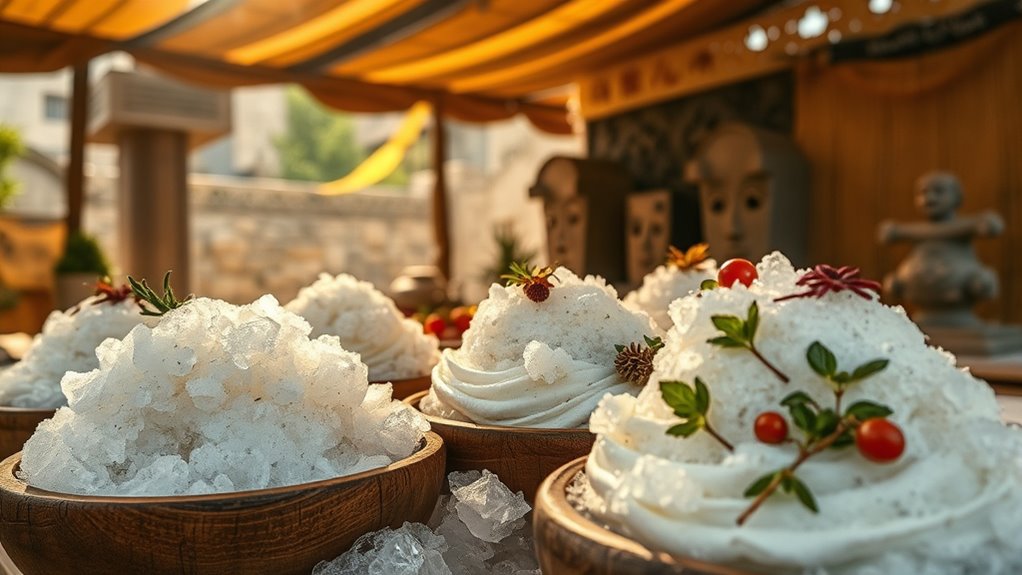Ancient civilizations started creating cold, sweet treats thousands of years ago using natural ice and snow mixed with fruits, honey, or milk. In China and Persia, they developed early forms of frozen desserts like snow mixed with rice or flavored syrups. Medieval Europeans collected snow for icy confections with honey or fruit. Over time, advances in technology helped perfect these treats into the ice cream we enjoy today. If you keep exploring, you’ll discover how these traditions evolved into modern favorites.
Key Takeaways
- Ancient civilizations used natural ice and snow combined with fruits, honey, or milk to create early frozen treats.
- China and Persia developed primitive frozen desserts around 200 BC and 400 BC, often symbolizing wealth and status.
- Medieval Europe stored snow underground and mixed it with honey, fruit, or wine to make sweet icy confections.
- Technological advances in refrigeration enabled more sophisticated and widespread production of ice cream over centuries.
- Frozen desserts have historically signified luxury and social hierarchy, reflecting a long-standing human desire for cooling, sweet treats.

Ice cream may seem like a modern treat, but its roots stretch back thousands of years to ancient civilizations. Long before the invention of refrigeration, people sought ways to enjoy cold, invigorating desserts. These early frozen desserts were often simple, using natural ice or snow combined with fruit juices, honey, or milk to create a cooling treat. Across different regions, you’ll find evidence of these early efforts to craft frozen delights, showcasing humanity’s desire for something sweet and cooling during hot seasons. These historical recipes laid the groundwork for what would eventually become modern ice cream, evolving over centuries into a variety of forms and flavors.
Ice cream’s origins date back thousands of years, showcasing humanity’s timeless love for cold, sweet treats.
In ancient China, around 200 BC, people began experimenting with snow mixed with milk and rice, creating a primitive form of frozen dessert that was reserved for royalty. Meanwhile, in Persia, around 400 BC, a popular dish called “frozen fruit sorbet” was developed, utilizing flavored syrups poured over crushed ice. These early frozen desserts were often reserved for the wealthy or powerful, symbolizing status and luxury. As trade routes expanded, recipes and techniques spread across Asia, the Middle East, and Europe, inspiring new variations and methods. Historical recipes from these civilizations reveal a shared passion for cooling treats, even if the ingredients and presentation differed.
In Europe, during the Middle Ages, the concept of frozen desserts gained popularity among royalty and aristocrats. They often employed snow collected in winter, stored in underground chambers, and combined it with honey, fruit, or wine to create sweet, icy concoctions. Italian chefs, in particular, experimented with early versions of sorbet, blending fruit purees with frozen ice, which became the precursor to modern gelato. These recipes often involved intricate preparation and a keen understanding of how to manipulate temperature and ingredients to achieve the desired texture and flavor. Despite the limited technology of the time, these historical recipes demonstrate a sophisticated approach to crafting frozen desserts, reflecting a blend of culinary artistry and scientific curiosity.
Over the centuries, the development of ice cream as we know it today was driven by advances in refrigeration technology and the desire to recreate those luxurious frozen treats more efficiently. But understanding its origins, from snow cones to emperor’s delicacies, reveals a fascinating history rooted in human ingenuity and the universal craving for something cold, sweet, and satisfying. Your modern ice cream, in many ways, is the culmination of centuries of experimentation with frozen desserts and the enduring appeal of these ancient recipes.
Frequently Asked Questions
When Was Ice Cream First Invented in History?
You’re curious about when ice cream was first invented, right? Well, frosty confections date back centuries, with early forms created by ancient Chinese and Persians using ice and fruit. During the 4th century BCE, historical refrigeration methods allowed these treats to become more refined. By the 16th century, ice cream as we know it started to appear in Europe, showcasing centuries of innovation and culinary evolution.
Which Ancient Civilization First Created Frozen Desserts?
Imagine lush gardens and icy mountains—ancient civilizations harnessed nature’s chill to create frozen desserts. You discover that the Chinese pioneered these icy treats over 2,000 years ago, blending ancient culinary innovations with clever preservation techniques. They used snow and salted ice to chill flavored liquids, laying the groundwork for frozen delights. Their ingenuity transformed simple snow into decadent treats, showcasing early mastery of both culinary art and historical preservation techniques.
How Did Early Cultures Preserve Ice Before Refrigeration?
You might wonder how early cultures preserved ice before refrigeration. They used natural ice storage and ancient cooling techniques, such as underground chambers, insulated pits, and snow houses, to keep ice cool longer. In colder climates, they gathered snow and packed it with insulating materials like straw or sawdust, preventing melting and preserving it for extended periods. These methods showcase their ingenuity in utilizing nature’s resources for cooling.
Were There Any Legendary or Mythological Stories About Ice Cream?
You might find it fascinating that mythological symbolism surrounds ice cream, with stories portraying it as divine or magical. Legends often describe legendary recipes passed down by gods or mythical beings, emphasizing its special status. These stories highlight ice cream’s cultural significance, making it more than just a treat. Such myths reveal how societies romanticized and celebrated ice cream, elevating it to legendary status through imaginative tales.
Did Ancient Rulers Have Special Recipes or Unique Flavors?
Did you know ancient rulers had their own royal recipes and legendary flavors? They often used rare ingredients like saffron, honey, and exotic fruits to create luxurious treats fit for royalty. These unique recipes showcased power and wealth, making ice cream a symbol of prestige. You can imagine emperors sampling decadent flavors, elevating ice cream beyond simple dessert to a symbol of status and indulgence in ancient times.
Conclusion
So, as you can see, ice cream’s history is a rich tapestry woven through centuries. From snow-capped mountains to royal courts, it’s like a timeless treasure chest filled with delights. You now hold the scoop on this frosty journey, realizing how each frozen treat is a cool whisper from the past. Next time you enjoy ice cream, remember—you’re tasting centuries of history melting perfectly in your mouth.









